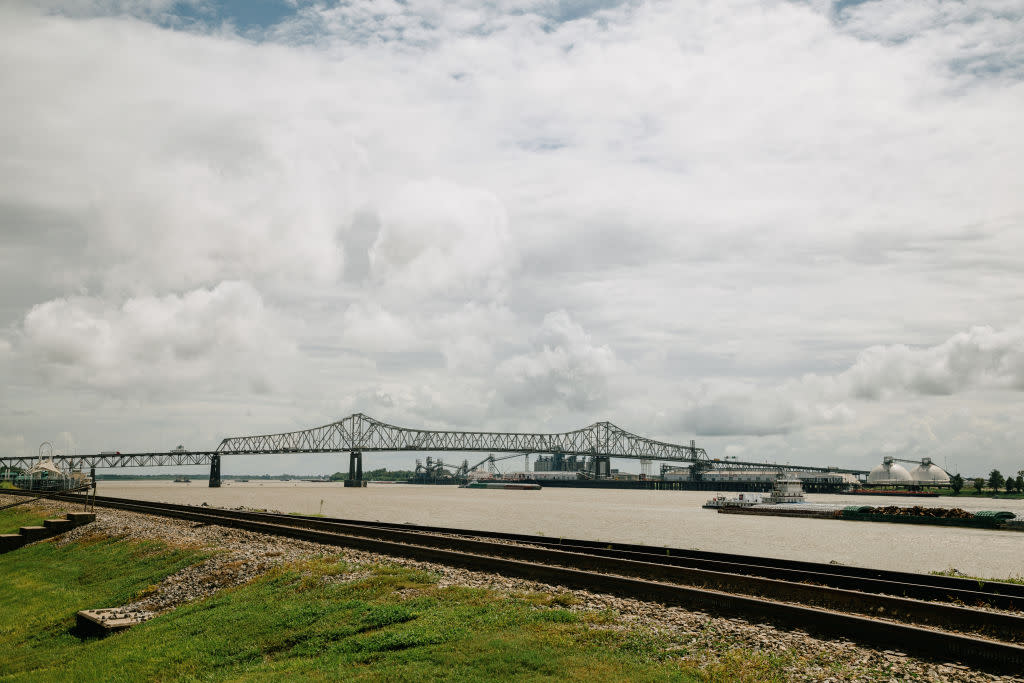What to Know About the Saltwater Threat to Louisiana’s Drinking Water Supply

- Oops!Something went wrong.Please try again later.
The Mississippi River Bridge in Baton Rouge, Louisiana, pictured here in 2022. Credit - Bryan Tarnowski—Bloomberg via Getty Images / AP
A long-lasting drought in Louisiana is impacting the drinking water in the Mississippi River, posing a risk for the state’s near 5 million residents, and particularly those in the New Orleans area.
At the root of the cause are low freshwater levels in the Mississippi River, making it vulnerable to a process known as saltwater infusion, which brings an influx of saltwater from the Gulf of Mexico. This marks the second year in a row when drought has decreased the flow of the water in the Mississippi River. Much of the central and southern regions of the state are currently recording exceptionally high drought levels.
The process is cause for concern. Louisiana Gov. John Bel Edwards said on Friday that he is just a few days away from requesting a declaration of emergency from the federal government to help. “Unfortunately, we just haven’t had the relief from dry conditions ... so that intrusion is worsening, in the sense that it’s moving further up the river,” said Edwards during a Friday news conference.
In the meantime, New Orleans Mayor LaToya Cantrell signed an emergency declaration for the city on Friday. And some areas of the state, including Plaquemines Parish and Empire Bridge in the southeast, are currently under drinking water advisories.
Here’s what to know about Louisiana’s water emergency.
What is happening in the state?
When climate conditions are balanced, the movement of freshwater stops saltwater from infiltrating bodies of freshwater. But in a process called saltwater intrusion, the zone of transition between saltwater and fresh groundwater is affected and saltwater enters the aquifer, reducing the amount of freshwater.
Droughts are relatively common in Louisiana, where periods of dryness are a natural part of their climate. But global warming is increasing the risk of drought all across the country. The Southwest is expected to be particularly affected by droughts that occur more frequently, intensely, and for longer periods of time, according to the Center for Climate and Energy Solutions.
“Most of the state has been experiencing prolonged drought and above-average heat, and has presented a number of challenges including wildfires, drought, heat-related deaths, injuries and so forth and now saltwater intrusion,” said Edwards during a press conference Friday.
How are officials trying to combat it?
Officials built an underwater sill in the Mississippi River to reduce the flow of saltwater in July. Authorities are working on expanding that sill by 25 feet, but construction would take at least another 24 days and will only delay saltwater intrusion by another 10 to 15, according to a press release from the Louisiana Governor’s office.
The best thing that can be done to help avoid greater saltwater intrusion, however, is out of the officials' hands. “I found out today that the forecast is for above average amounts of precipitation in winter. But that’s still several months away,” said Edwards. “And what we need most in Louisiana right now, for the Mississippi River, we need rain further up north in the Ohio Valley.” About ten inches of rain would be sufficient to help the river flow high enough to push back against saltwater.
For now, authorities advise residents to stay calm and avoid hoarding bottled water. “We just need to make sure that we are aware of the situation and that we don’t do anything that would exacerbate it and do anything that we reasonably can, as soon as we can, to help us get through this period of time,” Edwards said.
The U.S. Army Corps of Engineers will also be sending 36 million gallons of freshwater daily to affected areas in southern Louisiana.
How is climate change impacting the state of Louisiana?
A 2016 Enviornmental Protection Agency report predicted that climate change in Louisiana would bring about severe floods and droughts, with rainfall expected to “arrive in heavy downpours,” impacting the soil’s health.
The Mississippi River has been at the center of climate emergencies for years, as intense flooding impacted the region in 2019, a year that was particularly rainy. Now, in 2023, we're seeing the opposite. In August, residents were impacted by the Tiger Island Fire—the largest wildfire in Louisiana’s history—which forced 1,200 people to evacuate and took down at least 20 homes and structures. That same month Gov. Edwards issued a state of emergency due to record-breaking heat levels after temperatures reached the mid-90s and low-100s for weeks.
Aside from concerns about access to drinking water, increased temperatures due to climate change have already impacted people’s health. The state passed its average number of heat-related deaths and emergency room visits in mid-August, according to local public radio station WWNO.
Contact us at letters@time.com.

